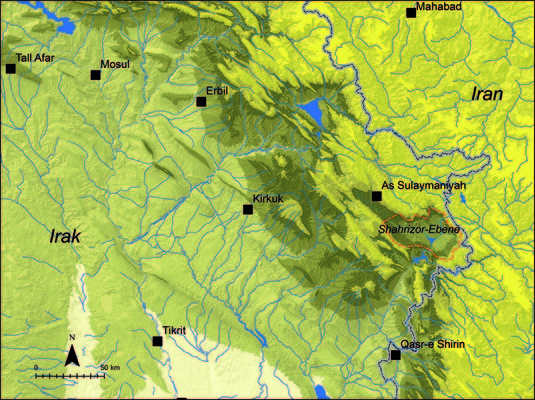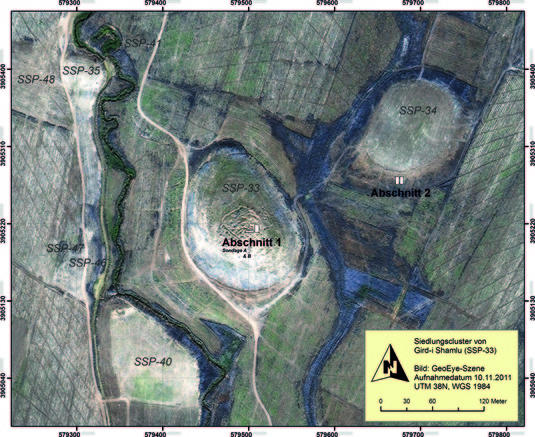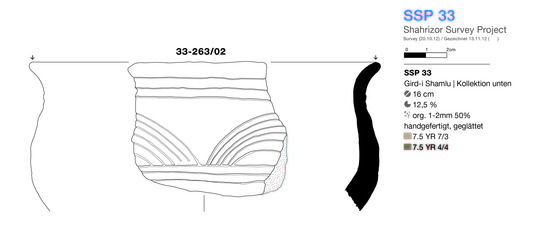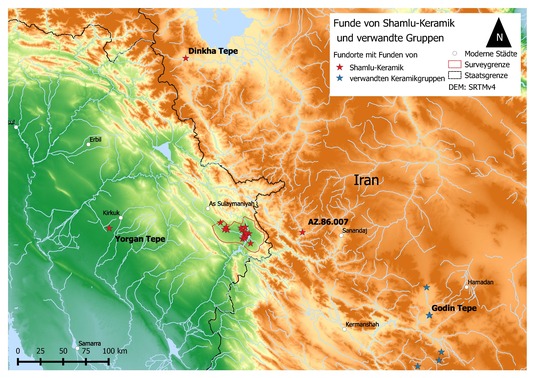Emmy Noether-Project: Flight – Migration – Interaction
Flucht – Migration – Interaktion. Artefaktbezogene Diversität in altorientalischen Kontexten des 3. und 2. Jahrtausends v. Chr.
Project Management: Dr. Simone Mühl, M.A.
Project staff:
Early Bronze Age: Manuela Heil, M.A. „Die bemalte Keramik aus Gird-I Shamlu im Kontext transregionaler Netzwerke des 3. Jahrtausends v. Chr.“
Magnetics: Marion Scheiblecker, M.A. „Geophysikalische Prospektion in der Shahrizor-Ebene. Eine Analyse zur Raumnutzung in ländlichen Siedlungen und urbanen Einzugsbereichen altorientalischer Siedlungssysteme“
Technical drawings: Eva Schmalenberger, MA
Local cooperation partners:
Directorate of Antiquities Sulaymaniyah
General Directorate of Antiquities Erbil
Summary
Within the framework of the project „Flucht - Migration - Interaktion. Artefaktbezogene Diversität in altorientalischen Kontexten des 2. und 3. Jahrtausends v. Chr.“(Flight-Migration-Interaction. Artefact-related diversity in Ancient Near Eastern contexts of the 2nd and 3rd millennium B.C.") we examine questions of cultural influence, material change and the diversity of Ancient Near Eastern cultures in a multi-disciplinary research team. Our focus will be on patterns of flight and migration movements that can be explained by an abrupt change in material residues (a.o. pottery) in archaeological contexts. At the ancient hill settlement Gird-i Shamlu in the Shahrizor plain at the Iraqi-Iranian border in Southern Kurdistan we track the possible flight movment that took place in that region about 3500 years ago by means of state-of-the-art archaeological means. Related examinations with the help of archaeo-magnetic field prospection enable us to comprehend this phenomenon in a greater area with contemporaneous settlements.
Excavations at Gird-i Shamlu
Gird-i Shamlu (Gird – kurd.: hill) is situated at a wadi of the same name in the midst of the Shahrizor plain approx. 45 km south-east of Sulaymaniyah in Iraqi Kurdistan near the Iraqi-Iranian border.


The hill was populated from the beginning of the third millennium B.C. In the early second millennium B.C., archaeological remains are evidence of a connection to the material culture of Mesopotamia.
Wheel-turned pottery and burials hardly differ from the finds and evidence known from the Hamrin area or from Old Babylonian Southern Mesopotamia. Afterwards, however, there is a break: in the pottery sequence, but also with other finds as in the Lithic Age, significant changes can be recognised. The pottery is now made by hand and no longer turned on a wheel, as before. It is adorned with characteristic carved patterns and exhibits a very limted repertory of forms. Bottles and bowls from burnt clay are lacking. Perhaps vessels made from wood or other perishable material such as leather was used instead.

Since these changes cannot be explained through regional development, we suppose that they are associated with the arrival of a population group, presumably from one of the valleys in the Western Zagros area. For in the near surroundings of the Shahrizor plain and in the Greater Mesopotamian area this phenomenon had not yet been observed. However, there are distant references further up in the Iranian Highlands. Technologically seen there are differences, and also the finds from Shamlu seem to date further back. Thus, the exact origin of the new production methods in the Shahrizor plain is still unclear.

Regional and Mesopotamian written sources from the end ot the 18th century B.C. tell of population displacements in the entire greater area of that epoch, which were in part related to acts of war. Intruders from the Western Zagros area and the resulting flight movements in the region are mentioned. With the destruction of a regional governor's palace in Shusharra - today's find spot Shemshara in the near Rania plain - historical tradition from that region ceases and befog the subsequent centuries.
Judging from the C-14 data from the most recent level associated with this pottery, the ceramics date to the end of the 17th century B.C.. Additional excavations are meant to help gain further information on the houses, the economy, the social structure and also on the consumption habits of the possibly new inhabitants of Gird-i Shamlu. First findings rendered relicts of architecture which contradict the original hypothesis that the people were nomades keeping animals in the settlement and hardly leaving behind any housing relicts. People used to build massive mud brick houses covering the floors and constructing roofs with rush mats. They also farmed the surroundings intensively. They mostly cultivated cereals such as emmer, wheat, einkorn and barley, but also unusual sorts like broomcorn millet (panicum miliaceum). Sheep, goats and pigs provided meat.
In order to grasp and explain the changes at the find spot, we also examine the material culture of preceding epochs there. To this purpose, we excavate in the Lower Town, where large areas exhibit remains of settlements dating back to the early third millennium B.C.. This early settlement was destroyed by fire twice and thus offers snap-shot-like insight into the ways of living at the find spot in the respective epochs. For instance, excavations in spring 2015 and autumn 2016 brought to light storage rooms and a workshop for the production of firestone tools. Smaller objects such as terracotta models or seals are evidence of the craftsmanship that was part of everyday life at Gird-i Shamlu 5000 years ago.
Literature:
Mühl, S./Faßbinder, J. 2015. Archaeological geophysics in the Shahrizor plain (Iraqi Kurdistan). Archaeologia Polona 53, 481–485.
Fassbinder, J./Hofmann, I./Mühl, S. (2015), “Archäologisch-geophysikalische Prospektion in Kurdistan“, Denkmalpflege Informationen 160, 71-73.
Mühl, S. (2013), Siedlungsgeschichte im mittleren Osttigrisgebiet vom Neolithikum bis in die neuassyrische Zeit, ADOG 28, Wiesbaden.
Altaweel, M./Marsh, A./Mühl, S./Nieuwenhuyse, O./Radner, K./Rasheed, K./Saber, A.S. (2012), “New Investigations in the Environment, History, and Archaeology of the Iraqi Hilly Flanks: Shahrizor Survey Project 2009-2011”, Iraq 74, 1-35.
Mühl, S. (2012), “Human Landscape - Site (Trans-) Formation in the Transtigris Area”, in: R. Hofmann, F.-K. Moetz, J. Müller (Hrsg.), Tells. Social and Environmental Space, UPA 207, Bonn, 79-92.
Literature online: https://lmu-munich.academia.edu/SimoneMühl
Contact:
Dr. Simone Mühl, M.A.
Institut für Vorderasiatische Archäologie
Ludwig-Maximilians-Universität München
Geschwister-Scholl-Platz 1
80539 München
Email: Simone.Muehl@vaa.fak12.uni-muenchen.de

